PrEP and PEP for HIV infection

There are two types of HIV prophylaxis available for prevention of HIV, namely pre-exposure prophylaxis (PrEP) taken before the encounter and post-exposure prophylaxis (PEP) taken after the encounter.
PrEP is taken by HIV-negative individual to reduce their risk of getting HIV if they are exposed to the virus from sexual encounter or by injection. PrEP can stop the virus from spreading throughout your body. With proper use, PrEP can reduces the risk of getting HIV via sex by 99% and 74% via injection drug once.
HIV PrEP can be taken in several different ways depending on your unique lifestyle. The most common and effective way to take it is with a daily dose. Research have have shown this method provide the best level of protection against HIV.
HIV PrEP is recommended for HIV-negative individuals with high risks such actively using injection drugs, having HIV-positive partner or partner that use injection drugs, having multiple partner that has unknown HIV status and does not practice safe sex and having sex with commercial sex workers.
Because no prevention strategy for sexually active people is 100% effective, individuals taking PrEP are still encouraged to use other effective prevention strategies to maximally reduce their risk by using condoms, consistently and correctly, avoid high risk sexual behaviours and sharing needles and getting regular HIV and STD testing.
PEP on the other hands is a short course medication taken after a possible exposure to HIV to prevent the virus from spreading. It should only be used in emergency situation and taken as soon as possible, within 72 hours (3 days) after the exposure. The earlier the treatment, the higher the chances of success. So, every minute counts!
PEP can be taken by HIV-negative individual with high-risk HIV exposure within the last 72 hours from sexual encounter (condrom break with a partner of unknow HIV status or HIV positive, encounter with commercial sex workers, sexual assault), sharing of contaminated needles or equipments to inject drugs and health workers with needlestick injuries or exposure of HIV contaminated blood or bodily fluid in the eye or from a break in the skin. PEP does not prevent 100% of HIV infections but used correctly, it can reduced your risk of getting HIV infection by about 80%.
If you have any question about HIV or HIV prophylaxis, talk to our doctor for more information.



